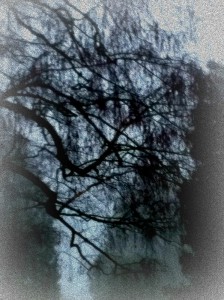An essay by Dr. Balini Enoras, as transcribed by K. A. Blaha
Art by Dawn Vogel
Introduction
Since our arrival on this world several years ago, we have adapted to a variety of new and unexpected circumstances. By far the greatest challenge encountered has been the mysterious “fog.” It is unclear whether fogs are mindless predatory ensembles of tiny insects or some sentient organization of these independent units. What is clear is that they are deadly, with several deaths in the last month alone.
In a recent study, we proved the existence of the fog organism in a controlled experiment. In this paper, we discuss what is known about the fogs. We discuss strategies for surviving, avoiding, and eradicating them. We debunk several myths about fogs and fog behavior. We hope that this paper will reduce fog-related fatalities, and pave the way for future research.
#
What is known about fogs?
When we pose this question, we mean in the scientific sense. In the common parlance, the fog is a vaporous apparition, similar in aspect to the more innocuous fog of Earth. Both terrestrial fog and our fogs appear after and during rain. They fly between 15 cm and 1.5 m above the ground, though it is not known whether this is by preference or by rule.
Contact with a fog above the shoulders results in near-instant death for every observed macroscopic organism. Neural tissues, especially brain tissues and neurons, show extensive damage after death by fog. The mechanism for this action is still unknown. The claim that fogs feed on “neurolytic” energy (note from the author: we are unfamiliar with this form of energy) is wholly unproven.
In the first scientific documentation, a fog seemed to disintegrate into the sandy ground. We collected this sand and investigated it in a controlled environment. In experiments, we found that fogs “emerged” from the sand sample when moisture density reached 60 percent. The fogs disappeared again when the humidity fell below about 25 percent. This agrees well with anecdotal observations that fogs appear in the presence of rain. (Note from the author: statistically, it has rained more often in this year than in the year of our arrival. This only makes the work presented here more important.)
When we examined the soil sample under magnification, we observed encapsulated insects mixed with the grains of sand. These insects comprise a fog, but they appear to be completely inactive when in this state. Their encapsulation resembles the survival strategies of African lungfishes or waterbears observed on Earth. While they are encapsulated, they are nearly impervious to their surroundings (See diagram in Figure 1 of encapsulated and emerged insects).
We mention above that fog insects emerge at high humidity. We also discovered that insect emergence is sensitive to the density of nearby insects. When we hydrated only small samples, no insects emerged. Unless roughly 1,000 insects were present, none would emerge. This suggests that collective action is somehow essential to the mechanism of the fog. However, this does not guarantee sentience.
To read the rest of this story, check out the Mad Scientist Journal: Winter 2014 collection.
Balini Enoras received his PhD in cellular biology in 2199, specializing in manipulating mitochondrial structures. Since leaving Earth and arriving on this world, he has explored a wide variety of subjects, from xenobiology to weather patterns. He is the foremost expert on native insect physiology. He conducted the first experiments demonstrating the existance of the fog in 2205. Since then, he has studied strategies for adapting to native species, while working to improve scientific models.
K. A. Blaha, another mad scientist, recently received her PhD in chemical engineering with research in chaos and nonlinear dynamics. Her fiction has appeared in Swords and Sorcery Magazine and The Colored Lens. She writes about science, photography, and science fiction at her blog (www.vironevaeh.com). Her science-fiction themed fairy tales, set in Balini’s universe, are available free in the ibooks store, including over 50 original illustrations.
Dawn Vogel has been published as a short fiction author and an editor of both fiction and non-fiction. Although art is not her strongest suit, she’s happy to contribute occasional art to Mad Scientist Journal. By day, she edits reports for and manages an office of historians and archaeologists. In her alleged spare time, she runs a craft business and tries to find time for writing. She lives in Seattle with her awesome husband (and fellow author), Jeremy Zimmerman, and their herd of cats. For more of Dawn’s work visit http://historythatneverwas.com/
Follow us online:
